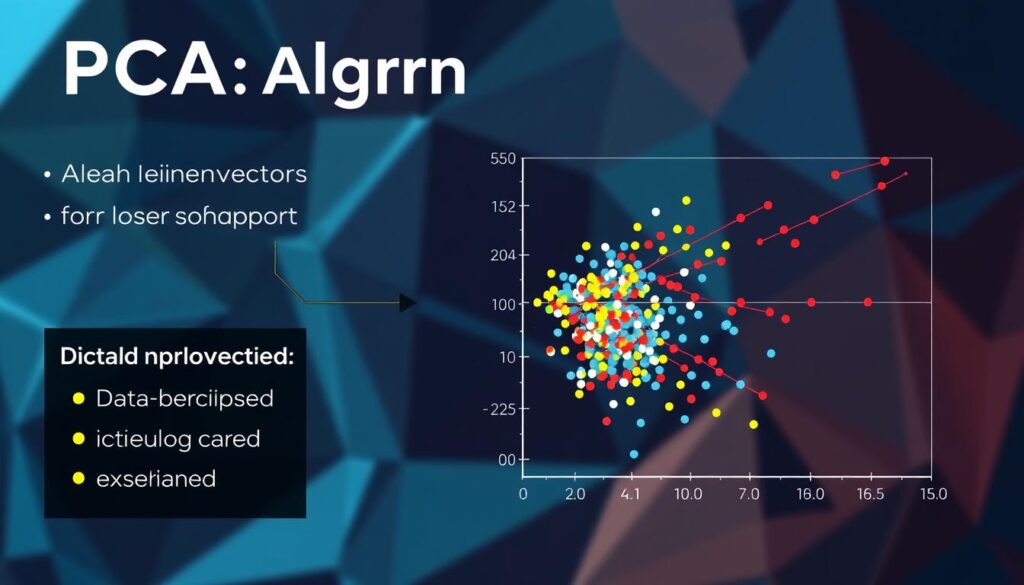Did you know that Principal Component Analysis (PCA) can reduce the dimensions of data by up to 90% while preserving most of its variability? This remarkable ability makes PCA a fundamental tool in data science, enabling more efficient computation and enhanced model performance1.
For data scientists and machine learning enthusiasts, dimensionality reduction is essential, and PCA stands out as one of the most powerful techniques available. By leveraging PCA in Python, through libraries like Scikit-Learn, professionals can significantly simplify complex datasets, making them easier to analyze and visualize without compromising their integrity2.
Initially introduced by Karl Pearson in 1901, PCA has come a long way and is now widely applied in fields such as data science, genetics, and computer vision. This method utilizes an orthogonal transformation to convert a set of possibly correlated features into a set of values of linearly uncorrelated variables called principal components3. Let’s explore the world of PCA and understand how mastering this technique can enhance your data science projects.
Key Takeaways
- PCA can transform high-dimensional data into a lower-dimensional representation for simplified computation.
- Standardizing data is critical for PCA to ensure features have a mean of 0 and a standard deviation of 1.
- Eigenvalues and eigenvectors are foundational elements in identifying principal components.
- Implementing PCA in Python with libraries like Scikit-Learn is a streamlined process.
- Using PCA in data analysis aids in visualization, noise reduction, and improved computational efficiency.
- The covariance matrix and SVD are key mathematical concepts underlying PCA.
Introduction to Principal Component Analysis (PCA)
Principal Component Analysis (PCA) is a cornerstone in data science, facilitating the diminution of high-dimensional data into more tractable forms without incurring significant loss of information. Prior to exploring the basics of PCA implementation, it is imperative to comprehend the fundamental essence of PCA and its intrinsic advantages.
Karl Pearson introduced PCA in 1901, transforming data into a new coordinate system where the greatest variances are aligned with the initial few principal components. This transformation, mathematically formulated, captures the essential aspects of the data while minimizing the loss of core information4.
A critical aspect of understanding PCA lies in its efficacy in dimensionality reduction tasks. It excels in managing high-dimensional datasets, such as those with 460 dimensions, making it indispensable for handling complex data efficiently5. The method employs Singular Value Decomposition (SVD) to achieve this reduction, aiming to preserve the maximum variance within the dataset during transformation4.
As an introduction to PCA, its extensive applications in data science are noteworthy. PCA facilitates exploratory data analysis, reduces noise in datasets, and visualizes high-dimensional data—a critical analytical advantage. It also aids in compressing images and detecting anomalies, highlighting its versatility across diverse domains56.
Understanding PCA necessitates familiarity with key terminologies such as eigenvalues and eigenvectors, as well as the concept of the covariance matrix—an essential matrix that delineates the degree to which variables covary. By computing eigenvalues and eigenvectors from the covariance matrix, PCA identifies the direction of maximum variance, enabling dimensionality reduction4.
The contributions of PCA in various algorithms and libraries like Scikit-Learn, TensorFlow, and R further solidify its position in the data science toolkit. Techniques employed in PCA, such as the truncation of less significant components for image compression, play a significant role in optimizing storage and computational resources5.
In conclusion, understanding PCA encompasses appreciating its mathematical foundation, practical applications, and its invaluable role in simplifying complex data structures. Whether embarking on exploratory data analysis or compressing large datasets, PCA’s versatility and efficiency render it an indispensable ally in the realm of data science456.
The Importance of Dimensionality Reduction in Data Analysis
Dimensionality reduction is a cornerstone in data analysis, transforming voluminous datasets into more tractable forms. This transformation enables data scientists and analysts to glean deeper insights. The benefits of dimensionality reduction are multifaceted, spanning from the enhancement of visualization to the optimization of computational efficiency and the reduction of overfitting in machine learning models.
Enhancing Visualization
The primary benefit of dimensionality reduction lies in its ability to condense high-dimensional data into two or three dimensions, facilitating visualization. Principal Component Analysis (PCA) identifies the principal components that capture the most variance within a dataset, aiding in visualization. For instance, PCA for visualization is instrumental in creating scatterplots of principal components, aiding in the understanding of data distribution and the identification of patterns or anomalies. This capability enhances the clarity of complex data, promoting more effective decision-making processes.
Reducing Overfitting in Machine Learning Models
Dimensionality reduction, through techniques such as PCA, significantly minimizes overfitting by eliminating less critical features. This practice, known as PCA to reduce overfitting, ensures that models retain the essence of the data while discarding noise and redundant information. Overfitting occurs when models become overly complex, capturing noise as significant patterns. PCA mitigates this risk by focusing on the most variance-explanatory components, resulting in more robust training models.
Improving Computational Efficiency
Another significant advantage of dimensionality reduction methods, such as PCA, is their enhancement of computational efficiency. High-dimensional datasets often incur increased computational costs and time-consuming analyses. By reducing dimensions, PCA streamlines computational processes, making them more efficient and less resource-intensive. This is critical in handling large-scale data and complex machine learning algorithms. Empirical studies show that applying PCA or SVD in data-intensive tasks, such as image compression or matrix completion, can preserve essential data traits while significantly reducing computation time78.
| Technique | Key Advantage | Common Applications |
|---|---|---|
| PCA | Maximizes Variance for Visualization | Exploratory Data Analysis, Feature Extraction, Noise Reduction |
| SVD | Flexible and Powerful; Ideal for Sparse Data | Image Compression, Collaborative Filtering, Latent Semantic Analysis |
| LDA | Enhances Class Separability | Pattern Recognition, Face Recognition |
The foundation of PCA can be credited to Karl Pearson who first introduced this technique in 19017.
Understanding the Mathematics Behind PCA
Principal Component Analysis (PCA) mathematics encompasses several critical concepts for effective dimensionality reduction. These include the computation of the covariance matrix, extraction of eigenvalues and eigenvectors, formation of principal components, and data projection. Each of these components is vital for transforming data into a more manageable form.
Covariance Matrix
The covariance matrix is central to PCA, illustrating the covariance between various features in the data. It is fundamental in understanding the relationships between variables in data analysis9. The matrix is symmetric, with orthogonal eigenvectors of unit length, which is characteristic of machine learning tasks9.
Eigenvalues and Eigenvectors
Following the computation of the covariance matrix, the extraction of eigenvalues and eigenvectors ensues. Eigenvalues signify the magnitude of variance in the direction of their corresponding eigenvectors. These eigenvectors delineate the directions of maximum variance in the data. This step is indispensable for identifying the principal components, which are instrumental in transforming the data into a new subspace9. The calculation of eigenvalues and eigenvectors from the covariance matrix is foundational for comprehending the relationships and patterns within the dataset.
Principal Components
The formation of principal components follows the determination of eigenvalues and eigenvectors. These components represent the new basis into which the data is transformed. They are linear combinations of the original variables, retaining most of the variance in the data9. The primary goal of PCA is to diminish the dimensionality of the dataset while preserving as much variance as possible.
Data Projection
The culmination of PCA mathematics is data projection. This step involves projecting the original data onto the new axes defined by the principal components. This reduction in dimensionality facilitates easier analysis and visualization. Data projection is essential for uncovering hidden structures within the data, a cornerstone of exploratory data analysis, noise reduction, and other applications9. PCA is widely applied across various fields, including data science, genetics, and computer vision, utilizing tools such as Scikit-Learn, TensorFlow, and R.
Implementing PCA in Python
Principal Component Analysis (PCA) is a seminal technique for dimensionality reduction, extensively utilized via PCA with scikit-learn in Python. This library facilitates the implementation of PCA, segmenting the process into discrete, manageable phases.
Using Scikit-Learn for PCA
The Scikit-Learn library presents a robust framework for PCA execution. It streamlines the process, enabling users to seamlessly fit and transform datasets. Notably, PCA Python code heavily relies on singular value decomposition (SVD), a cornerstone for least squares projection applications in both statistical and machine learning methodologies10. This reliance underpins the technique’s computational efficacy.

In scenarios where the rank of matrix \(X\) is less than or equal to the minimum of \(m\) and \(n\) (the number of observations and features, respectively), Scikit-Learn’s PCA efficiently navigates these configurations using full SVD10.
Step-by-Step PCA Implementation
The implementation of PCA in Python necessitates several critical steps. Initially, data standardization is imperative, transforming data to have mean zero and unit variance. Subsequently, the PCA calculation involves decomposing the covariance matrix, akin to matrix B in our example: \(\begin{bmatrix} 1 & 2 \\ 3 & 4 \\ 5 & 6 \end{bmatrix}\)11. This decomposition uncovers eigenvalues and eigenvectors, fundamental components defining data variance.
Utilizing PCA implementation in Python with Scikit-Learn, the eigenvalues obtained, such as [0.707, 0.707], signify variances along principal components11. The subsequent derivation of the transformed data, or principal components, is achieved using these eigenvectors.
Exploratory Data Analysis with PCA
Exploratory data analysis with PCA is invaluable for elucidating the structure in high-dimensional datasets. By reducing dimensions, PCA facilitates the visualization of complex data, revealing insights into the most significant features. For instance, the PCA result obtained with eigenvector decomposition revealed principal components: \(\begin{bmatrix} -2.82842712 & 0 \\ 0 & 0 \\ 2.82842712 & 0 \end{bmatrix}\)11, which underscore major data trends. Further, results from PCA implemented with SVD demonstrated a reduction in data complexity: \(\begin{bmatrix} -2.18941839 & 0.45436451 \\ -4.99846626 & 0.12383458 \\ -7.80751414 & -0.20669536 \end{bmatrix}\)11.
PCA in Python transcends being a mere tool, serving as a strategic advantage in data analysis. It empowers users to discern critical insights from vast datasets with unparalleled ease.
Visualizing the Results of PCA
PCA visualization techniques are indispensable for the effective interpretation of results. They unveil the underlying structure of data, revealing patterns and relationships that are often obscured in high-dimensional datasets. Scatterplots of principal components, in particular, offer insights into the clustering and separation of data points, facilitating a deeper understanding of the data’s intrinsic organization.
Scatterplots of Principal Components
Scatterplots PCA serve as a valuable tool for examining the principal components. They visually depict the distribution of data across new dimensions, highlighting outliers and clusters. For example, in the Iris dataset, plotting the first two principal components reveals the distinctiveness of the three iris species: Iris-setosa, Iris-versicolor, and Iris-virginica12. Such visualizations are fundamental in exploratory data analysis, guiding data scientists in their subsequent analytical endeavors.
Scree Plots for Explained Variance
PCA scree plots are instrumental in determining the number of principal components to retain. These plots display the eigenvalues associated with each component, indicating the variance explained by each. Typically, a scree plot exhibits a sharp decline followed by a plateau, aiding in the identification of the optimal number of components that capture the majority of the data’s variance13. This method is critical for achieving a balance between dimensionality reduction and information retention.
Heatmaps of Reduced Data
PCA heatmaps are effective in summarizing the patterns and associations within the reduced data. By representing the principal component scores in a matrix format, heatmaps provide a detailed overview of variable relationships. This visual summary is invaluable for large datasets, facilitating the rapid identification of variable interactions and correlations12. Heatmaps also complement other PCA visualization techniques, providing a distinct perspective on the reduced dataset.
The integration of scatterplots PCA, scree plots, and PCA heatmaps enables a thorough comprehension of principal components and their implications in data analysis. These visual tools are not only essential for assessing PCA outcomes but also for effectively communicating findings to stakeholders13.
Applications of PCA in Various Domains
Principal Component Analysis (PCA) emerges as a quintessential tool, transcending its utility across a plethora of domains. Its primary function lies in the simplification of complex data, facilitating an enhanced exploration and visualization of datasets of considerable intricacy.
Exploratory Data Analysis
In the realm of exploratory data analysis, PCA applications serve as a cornerstone, enabling the identification of the dataset’s most salient features. Through the transformation of original variables into principal components, PCA empowers researchers to depict high-dimensional data in lower dimensions, unveiling patterns and structures heretofore imperceptible14. This methodology is ubiquitous in data science, genetics, and computer vision, providing profound insights into voluminous datasets.
Noise Reduction in Datasets
The application of PCA for noise reduction entails the segregation and elimination of superfluous or noisy elements within datasets. By concentrating on principal components that embody the most pronounced variance in the data, PCA diminishes the dataset’s dimensionality, yet retains its quintessential characteristics. This technique augments data quality, enabling more precise subsequent analyses14.
Image Compression
Within the context of image compression, PCA endeavors to diminish redundancy by transmuting image data into principal components. This methodology retains the most critical information, discarding superfluous details, and compressing the file size without significantly compromising image quality14. Its applications are extensive, encompassing the storage and transmission of high-resolution images in sectors such as medical imaging and satellite photography.
Anomaly Detection
Anomaly detection represents another domain where PCA’s utility is evident. By accentuating variations and deviations from the norm, PCA applications in anomaly detection facilitate the identification of outliers and anomalous events within large datasets15. This technique is extensively employed in cybersecurity, finance, and industrial maintenance to monitor systems and promptly detect prospective issues.
Singular Value Decomposition, Python Algorithm, Linear Algebra, SVD Implementation
Singular Value Decomposition (SVD) is a cornerstone in linear algebra, extensively applied in image processing, computer vision, and industrial applications, including the Google rank algorithm16. It decomposes a matrix into orthogonal matrices \( U \) and \( V^* \), and a diagonal matrix \( D \) of singular values17. This decomposition facilitates the representation of the original matrix as a linear combination of low-rank matrices, enabling effective dimensionality reduction17.
The process of Singular Value Decomposition is fundamental to data science, often employed to address complex linear algebra challenges18. Implementing SVD in Python is straightforward through libraries such as NumPy and scikit-learn. Utilizing NumPy, the numpy.linalg.svd function performs SVD on a matrix, presenting singular values in a 1D array17. Scikit-learn’s TruncatedSVD class, on the other hand, facilitates dimensionality reduction by specifying the number of desired components, efficiently truncating surplus singular values17.
Consider a matrix \( A = \begin{bmatrix} 3 & 0 \\ 4 & 5 \end{bmatrix} \); its SVD yields three matrices: \( U \), \( \Sigma \), and \( V \), where \( A = U \Sigma V^T \), highlighting the significance and methodology of singular value determination and matrix decomposition16. This process is critical when translating complex programs, such as IDL’s SVDC and SVSOL functions, to Python’s numpy.linalg.lstsq function, simplifying the solution of linear least squares problems using SVD decomposition18.
Further, SVD is instrumental in exploratory data analysis and noise reduction, preserving essential information while discarding insignificant terms beyond the initial singular values17. Its utility extends beyond linear algebra, encompassing vital areas in data science, exemplified by matrix reconstruction and high-dimensional data compression for enhanced visualization and computational efficiency16.
| Algorithm | Implementation | Application |
|---|---|---|
| Singular Value Decomposition (SVD) | NumPy, SciPy, Scikit-Learn | Image Processing, Data Science, Machine Learning |
| Principal Component Analysis (PCA) | Scikit-Learn, TensorFlow, R | Exploratory Data Analysis, Feature Extraction, Visualization |
Diving into the PCA Algorithm
The PCA algorithm is a powerful tool for handling large, high-dimensional datasets effectively. It converts high-dimensional datasets into lower-dimensional ones, making it essential for various applications such as data science, genetics, and computer vision19.

Understanding the PCA algorithm requires recognizing the importance of standardization, selecting the right number of components, and a step-by-step breakdown of the algorithm’s implementation.
Step-by-Step Breakdown
Implementing the PCA algorithm involves several computational steps. First, the data matrix \(X\) is centered by subtracting the mean of each feature to ensure a mean of 0. Next, the covariance matrix \(X^TX\) is computed, followed by the sorting of its eigenvalues in decreasing order19. The eigenvectors of \(X^TX\) are then found, and the original data \(X\) is transformed into the PCA form \(Z\), with the goal of maximizing the variance of \(Z\) to retain valuable information20. This process is encapsulated in the Table below:
| Step | Description |
|---|---|
| Center Data | Subtract the mean of each feature from the data matrix \(X\) to center it around zero. |
| Compute Covariance Matrix | Calculate the covariance matrix \(X^TX\). |
| Sort Eigenvalues | Sort the eigenvalues of the covariance matrix in decreasing order. |
| Find Eigenvectors | Identify the eigenvectors of the covariance matrix \(X^TX\). |
| Transform Data | Transform the original data matrix \(X\) into the PCA form \(Z\). |
Impact of Standardization
Standardization is a critical step in the PCA algorithm because it ensures each feature contributes equally to the result19. Without standardization, features with larger scales can dominate the principal components, leading to biased results. Standardizing the data involves scaling features to have a mean of 0 and a standard deviation of 1, which can be easily achieved using libraries like Scikit-Learn in Python20.
Choosing the Right Number of Components
One of the key challenges when utilizing PCA is selecting PCA components wisely. The goal is to strike a balance between simplicity and the integrity of the original data. An effective method is to use a scree plot to visualize the explained variance and identify an “elbow point” where the variance accounted for starts to diminish significantly20. In practice, this often involves retaining components that account for a cumulative variance threshold (e.g., 95%), ensuring substantial information retention from the original dataset.
Advantages and Disadvantages of Using PCA
Principal Component Analysis (PCA), pioneered by Karl Pearson in 1901, has emerged as a fundamental technique for dimensionality reduction across disciplines such as data science, genetics, and computer vision21. This methodology transforms data into an orthogonal coordinate system, effectively diminishing the dataset’s dimensionality while retaining vital information22. This section explores the benefits of PCA, its limitations, and guidelines for its application.
Pros of PCA
The advantages of PCA are profound. It significantly enhances data interpretation by reducing its dimensionality without sacrificing critical data patterns. This technique is instrumental in minimizing computational costs, making it highly suitable for applications such as recommendation systems22. PCA also addresses the curse of dimensionality by transforming high-dimensional data into a lower-dimensional space21. It facilitates exploratory data analysis, noise reduction, data visualization, and image compression21.
Cons of PCA
Despite its advantages, PCA has notable limitations. A significant drawback is the risk of losing important information during the reduction process22. PCA is also sensitive to data scaling, necessitating standardization before application21. It can be computationally intensive and may not handle missing data well, potentially complicating analysis and reducing efficiency22. These limitations underscore the importance of a thorough assessment before applying PCA to any dataset.
When to Use PCA
Understanding PCA’s benefits and limitations is essential for determining its application. PCA is most beneficial in scenarios where reducing dataset dimensionality leads to more efficient and interpretable models. It is highly effective for high-dimensional datasets where visualization and computational efficiency are critical. PCA facilitates feature extraction, enabling better model performance by focusing on the most significant data patterns21. Yet, it should be employed with caution if the dataset contains critical but potentially lost information during dimensionality reduction22.
| Aspect | Details |
|---|---|
| Founder of PCA | Karl Pearson (1901) |
| Benefits | Enhanced data interpretation, reduced computational costs, addresses curse of dimensionality, noise reduction |
| Limitations | Potential information loss, sensitivity to scaling, computationally intensive2221 |
| Usage Guidelines | High-dimensional datasets, feature extraction, data visualization, ensuring critical information is preserved2221 |
PCA vs Other Dimensionality Reduction Techniques
Principal Component Analysis (PCA) stands out as a premier method for dimensionality reduction, celebrated for its prowess in retaining variance while condensing dimensions. Yet, when juxtaposed against other methodologies, PCA’s utility is seen to be context-dependent, each technique exhibiting unique advantages for specific analytical objectives.
Comparing PCA with LDA
PCA diverges from Linear Discriminant Analysis (LDA) in methodology. PCA endeavors to transform data into uncorrelated features that maximize variance, whereas LDA aims to enhance class separability by maximizing the discriminability between known classes. This dichotomy positions PCA as the preferred choice for unsupervised learning endeavors, whereas LDA’s focus on class separability renders it more suitable for supervised learning scenarios where class labels are available23. LDA’s inherent objective of augmenting class discriminability renders it invaluable for tasks such as data classification and pattern recognition.
PCA vs t-SNE
The comparison between PCA and t-Distributed Stochastic Neighbor Embedding (t-SNE) elucidates their disparate strengths. PCA excels in linear transformations, rendering it efficacious for simplifying data with a linear structure without compromising significant variance24. In contrast, t-SNE, a manifold learning technique, is adept at non-linear transformations, proving advantageous for visualizing complex, high-dimensional datasets24. Its capacity to maintain local structure in reduced dimensions positions t-SNE as the preferred tool for visualizing clusters and relationships in complex datasets.
PCA vs Autoencoders
The comparison between PCA and autoencoders reveals their distinct capabilities within the realm of dimensionality reduction. PCA relies on eigen decomposition of the covariance matrix to identify principal components, whereas autoencoders employ deep learning to execute non-linear transformations through neural networks25. This enables autoencoders to discern more complex patterns in data, rendering them effective for tasks such as image compression and anomaly detection. Autoencoders, integrated into frameworks like TensorFlow and Keras, offer robust solutions for managing high-dimensional, non-linear data25.
Real-World Examples of PCA
Principal Component Analysis (PCA) exhibits profound applications across multiple domains, underscoring its versatility and significance. Below, we explore real-world examples of PCA, illustrating its impact in genetics, finance, and computer vision.
PCA in Genetics
In genetics, PCA is instrumental for identifying and analyzing genetic variations across different populations. It reduces the dimensionality of large genetic datasets, facilitating the visualization of genetic diversity and the comprehension of population structures. For instance, PCA enables the separation of individuals based on genetic ancestry by projecting high-dimensional genetic data into a lower-dimensional space. This facilitates the detection of patterns and correlations26. Such a technique is invaluable in genome-wide association studies (GWAS), where the efficient processing of vast genetic data is imperative.
Finance Applications
The finance sector employs PCA for risk management and trend analysis. By dimensionality reduction, PCA uncovers the underlying factors influencing market movements. This methodology empowers financial analysts to model complex relationships between financial instruments, optimizing portfolio performance. Through PCA, analysts can identify principal components representing significant trends, aiding in the prediction of future market behavior27. PCA also aids in data noise reduction, leading to more precise risk assessments and decision-making processes.
PCA in Computer Vision
In computer vision, PCA is essential for image recognition and classification tasks. It transforms high-dimensional image data into a lower-dimensional form, extracting the most relevant features for object identification within images. This dimensionality reduction is critical for improving the efficiency and accuracy of machine learning models in image processing applications. For example, PCA enables the compression of images without significant information loss, facilitating faster processing and storage efficiency26. It is also utilized in face recognition systems, where it reduces image data to its essential components, aiding in facial pattern recognition.
The integration of PCA in real-world applications highlights its critical role across diverse fields, providing substantial advantages in handling, visualizing, and interpreting complex datasets. From genetic analysis to financial forecasting and image recognition, PCA continues to drive innovation and efficiency in data-driven decision-making processes.
Using PCA for Feature Extraction and Engineering
Principal Component Analysis (PCA) emerges as a cornerstone in the realm of feature extraction and engineering, significantly bolstering model efficacy through dimensionality reduction and retention of critical information. This methodology not only streamlines data complexity but also enhances the training efficiency and efficacy of machine learning models. As such, PCA stands as a quintessential tool in predictive analytics and various data science domains.
PCA’s efficacy lies in its ability to transform an n-dimensional feature space into a k-dimensional space with minimal variance loss, effectively addressing the curse of dimensionality28. This technique empowers researchers to adeptly manage high-dimensional datasets by prioritizing components based on variance explained29.
Feature Engineering Techniques
Feature engineering with PCA entails generating principal components that maximize variance within a dataset. This process leverages unsupervised learning principles to identify orthogonal axes—principal components—that capture significant data characteristics30. Utilizing tools such as `DimRed`, algorithms like sklearn PCA, SparsePCA, and TruncatedSVD are employed for dimensionality reduction and feature transformation30.
Benefits of Feature Extraction
PCA feature extraction yields manifold advantages, including reduced training times, noise elimination, and enhanced visualization capabilities. By transforming original variables into principal components, PCA facilitates simplified analyses while preserving the data’s essential structure29. For instance, in the iris dataset, reducing four dimensions to two resulted in approximately a 92.5% variance for the first component, exemplifying efficient feature extraction30.
Improving Model Performance
Employing PCA for model enhancement necessitates the selection of an appropriate number of principal components to ensure retention of essential features while minimizing dimensionality. This strategy is remarkably effective in scenarios such as image compression and anomaly detection, retaining critical features and augmenting model generalization capability28. Reduced dimensions also mitigate the risk of overfitting, elevating model robustness on novel data30.
| Technique | Application | Benefits |
|---|---|---|
| Principal Component Analysis | Dimensionality Reduction | Improves model performance, reduces training time, enhances visualization28 |
| SparsePCA | Sparse Data Sets | Simplifies model complexity, retains key features30 |
| TruncatedSVD | General Data Sets | Efficiently reduces dimensions, scalable for large data sets30 |
| Eigen Value Decomposition | Matrix Decomposition | Identifies major variance directions, useful for feature engineering30 |
Common Pitfalls and How to Avoid Them
Principal Component Analysis (PCA) is susceptible to several pitfalls that can diminish its efficacy. It is imperative to be aware of these common errors and employ strategic methodologies to circumvent them. This ensures the optimal utilization of PCA in data analysis.
Overlooking Standardization
The failure to recognize the necessity of standardization in PCA is a critical oversight. Standardization guarantees that each feature’s contribution to the Principal Components (PCs) is equitable. This is vital, as PCA’s efficacy hinges on the data’s variance. Without standardization, the results can be misleading. Grasping the PCA standardization importance is essential for refining your analysis outcomes.
Selecting Too Many Components
Another prevalent error in PCA is the selection of an excessive number of components. This can result in negligible information gains. The objective is to maximize variance capture with the fewest PCs. Utilizing scree plots for variance explanation can aid in determining the optimal number of components to retain.
Misinterpreting the Components
Interpreting PCA results accurately is a nuanced challenge. The components, being abstract, can be misinterpreted, leading to incorrect conclusions. It is critical to contextualize the PCs within the data framework and the original features. Through scatterplots, these components reveal valuable insights, necessitating meticulous analysis.
The norms of the column vectors in the domain matrices were provided for Python and MATLAB results to examine their unit lengths. Alignments of vector spaces in the domain and codomain can vary, including discrete and continuous sets of angles31.
By acknowledging these PCA pitfalls, analysts can sidestep common pitfalls and enhance PCA’s utility in their endeavors. This disciplined methodology is of particular significance in domains such as genetics, finance, and computer vision. These fields require precision and clarity due to the inherent complexity of their data32.
Advanced PCA Topics
In the domain of data science, advanced PCA techniques transcend the conventional boundaries of traditional PCA, enabling a more nuanced exploration of data. These methodologies provide efficacious solutions to the intricacies posed by voluminous and non-linear datasets.
Kernel PCA
Kernel PCA emerges as a formidable extension of PCA, adept at addressing the complexities inherent in non-linear data. Through the application of a kernel function, it implicitly transmutes the original data into a higher-dimensional realm, unveiling patterns that elude linear methodologies. This technique is invaluable in image recognition, where the non-linearity of patterns is a ubiquitous challenge33. Kernel PCA facilitates the identification of principal components within this transformed domain, unveiling insights that remain occluded in the original space33.
Incremental PCA
Incremental PCA is meticulously crafted for datasets that transcend the confines of memory, necessitating a piecemeal approach. Unlike traditional PCA, which demands the entirety of the dataset at inception, incremental PCA segments data into manageable batches. This modus operandi is quintessential for online learning and real-time applications34. Its adoption in streaming data environments is widespread, where models must perpetually update without the burden of processing the entire dataset anew34. Incremental PCA maintains the essence of dimensionality reduction and computational parsimony, rendering it an exemplary solution for the analysis of extensive datasets.
PCA in the Context of TensorFlow and R
PCA’s versatility is further amplified by its implementation in diverse programming environments, including TensorFlow and R. PCA using TensorFlow leverages the capabilities of deep learning frameworks to seamlessly integrate dimensionality reduction within neural networks, augmenting model efficacy and performance. TensorFlow’s optimized matrix operations facilitate the execution of PCA at scale34. In contrast, R’s arsenal of statistical tools and visualization capabilities positions it as a premier platform for exploratory data analysis and scientific inquiry. The adaptability of PCA in R caters to the preferences of statisticians and data scientists who favor an interactive and analytical paradigm35.
| Technique | Advantages | Applications |
|---|---|---|
| Kernel PCA | Handles non-linear data, finds obscure patterns | Image recognition, complex pattern detection |
| Incremental PCA | Suitable for large datasets, supports online learning | Streaming data, real-time applications |
| PCA using TensorFlow | Integration with deep learning, scalable | Neural network optimization, large-scale data processing |
| PCA in R | Robust statistical analysis, superior visualization | Exploratory data analysis, academic research |
Conclusion
Principal Component Analysis (PCA) stands as a cornerstone in the field of data analysis, a testament to the transformative power of big data. Its inception, attributed to Karl Pearson in 1901, has witnessed a metamorphosis into a quintessential component of data science, permeating disciplines such as genetics, computer vision, and machine learning. Through this discourse, we have navigated the foundational mathematics, practical Python implementations, and the extensive applications of PCA. This journey has underscored its role in dimensionality reduction, visualization enhancement, and the optimization of computational efficiency and model performance.
The exploration commenced with the significance of dimensionality reduction, progressing to a detailed examination of mathematical constructs like covariance matrices, eigenvalues, and eigenvectors. The utilization of Scikit-Learn for PCA implementation allowed us to engage in hands-on data visualization, employing tools such as scatterplots, scree plots, and heatmaps. These visual aids facilitated a deeper understanding of PCA’s role in our datasets. We also explored its practical applications, including noise reduction, anomaly detection, and image compression, highlighting its versatility across various domains.
Embracing PCA necessitates an awareness of its benefits and limitations. It offers a streamlined approach to data analysis by concentrating on the most influential components. Yet, it demands meticulous consideration to circumvent pitfalls such as overlooking standardization or misinterpreting components. The integration of Singular Value Decomposition (SVD) into our discussion revealed its synergy with PCA, facilitating matrix decomposition and aiding in noise reduction and feature extraction3637.
By mastering and strategically applying PCA, professionals can make more informed decisions, uncover hidden patterns, and drive innovation. This exhaustive PCA summary not only imparts theoretical knowledge but also empowers you to apply these insights in practical scenarios. It ensures a solid foundation for future endeavors in data analysis and beyond.
FAQ
What is Principal Component Analysis (PCA)?
Why is dimensionality reduction important in data analysis?
How does PCA improve computational efficiency?
What are the mathematical concepts behind PCA?
How can I implement PCA in Python?
What visualization techniques are useful for interpreting PCA results?
In which domains is PCA commonly applied?
How is Singular Value Decomposition (SVD) related to PCA?
What considerations are important when diving into the PCA algorithm?
What are the advantages and disadvantages of using PCA?
How does PCA compare to other dimensionality reduction techniques?
Can you provide real-world examples of PCA usage?
How does PCA aid in feature extraction and engineering?
What common pitfalls should I avoid when using PCA?
What are some advanced topics related to PCA?
Source Links
- Dimensionality Reduction Techniques — PCA, LCA and SVD – https://medium.com/nerd-for-tech/dimensionality-reduction-techniques-pca-lca-and-svd-f2a56b097f7c
- The Mathematics Behind Principal Component Analysis (PCA) – https://medium.com/@RobuRishabh/the-mathematics-behind-principal-component-analysis-pca-1321f6aeb2f7
- Introduction to Dimensionality Reduction – GeeksforGeeks – https://www.geeksforgeeks.org/dimensionality-reduction/
- Principal component analysis in Python – https://stackoverflow.com/questions/1730600/principal-component-analysis-in-python
- Introduction to Principal Component Analysis – https://towardsdatascience.com/introduction-to-principle-component-analysis-d705d27b88b6
- Dimensionality Reduction with PCA — Statistical and Mathematical Methods for Machine Learning – https://devangelista2.github.io/statistical-mathematical-methods/ML/PCA.html
- Master Dimensionality Reduction with these 5 Must-Know Applications of Singular Value Decomposition (SVD) in Data Science – https://www.analyticsvidhya.com/blog/2019/08/5-applications-singular-value-decomposition-svd-data-science/
- Dimensionality Reduction: A Comprehensive Guide with SVD, PCA, and LDA in Python – https://medium.com/@tam.tamanna18/dimensionality-reduction-a-comprehensive-guide-with-svd-pca-and-lda-in-python-6bf9b946b479
- Machine Learning — Singular Value Decomposition (SVD) & Principal Component Analysis (PCA) – https://jonathan-hui.medium.com/machine-learning-singular-value-decomposition-svd-principal-component-analysis-pca-1d45e885e491
- Singular Value Decomposition (SVD) – https://python.quantecon.org/svd_intro.html
- Python: Implement a PCA using SVD – https://stackoverflow.com/questions/60508233/python-implement-a-pca-using-svd
- Principal Component Analysis – https://sebastianraschka.com/Articles/2015_pca_in_3_steps.html
- machine-learning-articles/introducing-pca-with-python-and-scikit-learn-for-machine-learning.md at main · christianversloot/machine-learning-articles – https://github.com/christianversloot/machine-learning-articles/blob/main/introducing-pca-with-python-and-scikit-learn-for-machine-learning.md
- How to Use Singular Value Decomposition (SVD) In machine Learning – Dataaspirant – https://dataaspirant.com/single-value-decomposition-svd/
- Singular Value Decomposition and its applications in Principal Component Analysis – https://towardsdatascience.com/singular-value-decomposition-and-its-applications-in-principal-component-analysis-5b7a5f08d0bd
- #009 The Singular Value Decomposition(SVD) – illustrated in Python – https://datahacker.rs/009-the-singular-value-decompositionsvd-illustrated-in-python/
- Singular Value Decomposition (SVD) in Python – AskPython – https://www.askpython.com/python/examples/singular-value-decomposition
- Solve Singular Value Decomposition (SVD) in Python – https://stackoverflow.com/questions/12580019/solve-singular-value-decomposition-svd-in-python
- A Deep Dive into Dimensionality Reduction with PCA – https://towardsdatascience.com/a-deep-dive-into-dimensionality-reduction-with-pca-bc6f026ba95e
- Singular Value Decomposition (SVD) in PHP – https://stackoverflow.com/questions/960060/singular-value-decomposition-svd-in-php
- Principal Component Analysis(PCA) – GeeksforGeeks – https://www.geeksforgeeks.org/principal-component-analysis-pca/
- [Linear Algebra] Singular Value Decomposition and Principal Component Analysis – https://medium.com/@hiroshi.wayama/linear-algebra-singular-value-decomposition-and-principal-component-analysis-e3ff14f0d7f4
- importance of PCA or SVD in machine learning – https://stackoverflow.com/questions/9590114/importance-of-pca-or-svd-in-machine-learning
- Top 12 Dimensionality Reduction Techniques for Machine Learning – https://encord.com/blog/dimentionality-reduction-techniques-machine-learning/
- Dimensionality Reduction for Machine Learning – https://neptune.ai/blog/dimensionality-reduction
- Recommender System — singular value decomposition (SVD) & truncated SVD – https://towardsdatascience.com/recommender-system-singular-value-decomposition-svd-truncated-svd-97096338f361
- Using Numpy (np.linalg.svd) for Singular Value Decomposition – https://stackoverflow.com/questions/24913232/using-numpy-np-linalg-svd-for-singular-value-decomposition
- Dimensionality Reduction and Deep Dive Into Principal Component Analysis – https://towardsdatascience.com/deep-dive-into-principal-component-analysis-fc64347c4d20
- What Is Principal Component Analysis (PCA)? – https://www.analyticsvidhya.com/blog/2016/03/pca-practical-guide-principal-component-analysis-python/
- DimRed – Dimension Reduction Package – https://github.com/FabG/dimred
- Singular Value Decomposition algorithm – https://stackoverflow.com/questions/13015113/singular-value-decomposition-algorithm
- Singular Value Decomposition – https://dsdojo.medium.com/singular-value-decomposition-8c06303f9557
- PDF – https://web.stanford.edu/class/cs168/l/l9.pdf
- PDF – https://www.cs.cmu.edu/~venkatg/teaching/CStheory-infoage/book-chapter-4.pdf
- Linear Algebra in Python – https://codefinity.com/blog/Linear-Algebra-in-Python
- Singular Value Decomposition (SVD) – https://medium.com/@shruti.dhumne/singular-value-decomposition-svd-65a2c1ff9967
- Singular Value Decomposition (SVD) — Working Example – https://medium.com/intuition/singular-value-decomposition-svd-working-example-c2b6135673b5










